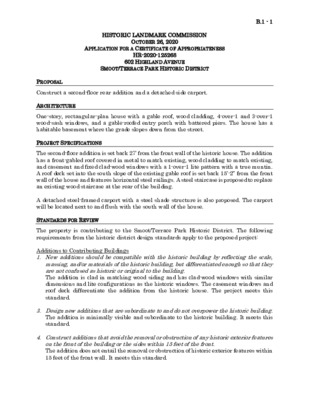B.1.0 - 602 Highland Ave — original pdf
Backup

B.1 - 1 HISTORIC LANDMARK COMMISSION OCTOBER 26, 2020 APPLICATION FOR A CERTIFICATE OF APPROPRIATENESS HR-2020-125268 602 HIGHLAND AVENUE SMOOT/TERRACE PARK HISTORIC DISTRICT PROPOSAL Construct a second-floor rear addition and a detached side carport. ARCHITECTURE One-story, rectangular-plan house with a gable roof, wood cladding, 4-over-1 and 3-over-1 wood-sash windows, and a gable-roofed entry porch with battered piers. The house has a habitable basement where the grade slopes down from the street. PROJECT SPECIFICATIONS The second-floor addition is set back 27’ from the front wall of the historic house. The addition has a front-gabled roof covered in metal to match existing, wood cladding to match existing, and casement and fixed clad-wood windows with a 1-over-1 lite pattern with a true muntin. A roof deck set into the south slope of the existing gable roof is set back 15’-2” from the front wall of the house and features horizontal steel railings. A steel staircase is proposed to replace an existing wood staircase at the rear of the building. A detached steel-framed carport with a steel shade structure is also proposed. The carport will be located next to and flush with the south wall of the house. STANDARDS FOR REVIEW The property is contributing to the Smoot/Terrace Park Historic District. The following requirements from the historic district design standards apply to the proposed project: Additions to Contributing Buildings 1. New additions should be compatible with the historic building by reflecting the scale, massing, and/or materials of the historic building, but differentiated enough so that they are not confused as historic or original to the building. The addition is clad in matching wood siding and has clad-wood windows with similar dimensions and lite configurations as the historic windows. The casement windows and roof deck differentiate the addition from the historic house. The project meets this standard. 3. Design new additions that are subordinate to and do not overpower the historic building. The addition is minimally visible and subordinate to the historic building. It meets this standard. 4. Construct additions that avoid the removal or obstruction of any historic exterior features on the front of the building or the sides within 15 feet of the front. The addition does not entail the removal or obstruction of historic exterior features within 15 feet of the front wall. It meets this standard. New Construction 1. New construction shall have the same street orientation and distance from adjacent buildings as the contributing buildings in the same block. New garages may have an alley-fronting orientation if in keeping with contributing garages in the district. The proposed carport is oriented to the street. The district includes rear garages as well as at least one street-facing porte-cochere. The project generally meets this standard. B.1 - 2 3. Setbacks for new construction of a new auxiliary building, such as a garage, shall be consistent with setbacks of the district’s contributing auxiliary buildings by taking the average of the existing setbacks of contributing auxiliary buildings on the same block face, or by aligning with the setback of one adjacent contributing auxiliary buildings. This may allow setbacks that are shallower than the base zoning. The carport is located flush with the front wall of the house, which is atypical for the district’s contributing buildings. The project does not meet this standard. 4. Design new buildings so that they are compatible with, but differentiated from, historic buildings in the district. The proposed carport is compatible with and differentiated from the principal house and other historic buildings in the district, due to its light, low design, modern materials, and subordinate positioning on the property. The project meets this standard. Except for the location of the carport, the project meets the applicable standards. COMMITTEE RECOMMENDATIONS The proposed project has received feedback on multiple occasions: at the July 17 Certificate of Appropriateness Review Committee (since renamed the Architectural Review Committee), September 16 Architectural Review Committee, and September 28, 2020, Historic Landmark Commission meetings. At each juncture, the plans have been revised to respond to feedback. Plans dated October 19, 2020, include the following revisions, clouded on the elevation drawings. The ridgeline of the proposed addition has been lowered below the maximum building height. The roof deck, previously extending to 7’ from the front wall of the house, has been pulled back to over 15’ from the front wall of the house, behind the side-facing gable roof. The carport, which previously protruded past the front wall, is now located flush with the front wall of the house. STAFF RECOMMENDATION Approve the addition and roof deck plans; request that the carport design be resubmitted with a setback consistent with the district’s contributing auxiliary buildings. The design is compatible, but its location is not. Pushing the carport back from the front of the house by even two or three feet would break up the plane of the old and new construction, and be less visually imposing, conforming better to the design standards for the historic district. LOCATION MAP B.1 - 3 PROPERTY INFORMATION Photos B.1 - 4 Primary (east) façade of 602 Highland Avenue. Source: Google Street View, May 2018.